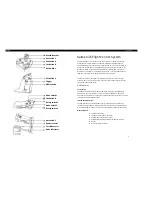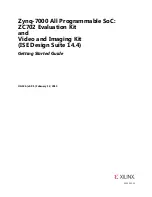
2
outdoor unit and existing control wires may be used for its
connection. Details are provided in sensor instructions.
INSTALLATION
STEP 1
—
Thermidistat Control Location
Thermidistat Control should be mounted:
S
Approximately 5 ft (1.5m) from floor.
S
Close to or in a frequently used room, preferably on an inside
partitioning wall.
S
On a section of wall without pipes or duct work.
Thermidistat Control should NOT be mounted:
S
Close to a window, on an outside wall, or next to a door
leading to the outside.
S
Exposed to direct light or heat from a lamp, sun, fireplace, or
other temperature--radiating objects which could cause a false
reading.
S
Close to or in direct airflow from supply registers and
return--air registers.
S
In areas with poor air circulation, such as behind a door or in an
alcove.
STEP 2
—
Set DIP Switches
There is a 4 section DIP switch within the Thermidistat Control
which must be properly set by the installer. It is easiest to set these
4 switches before the Thermidistat Control is mounted to the
wall, so STOP and complete the following steps:
1. Open hinged Thermidistat Control cover.
2. Remove cover completely by snapping it apart at hinge.
3. Open Thermidistat Control by pressing back half of the
right end of plastic case inward while, at the same time,
pulling front and back halves apart at the right end. The 2
halves will swing apart.
4. Snap hinge apart to completely separate the 2 halves.
5. Switches are located in upper right corner of circuit board.
To change switch position, use corner of a small
screwdriver to slide switch to opposite position.
6. After switches have been set, do not reassemble the 2
halves. The rear plastic will first be mounted to the wall.
A. Switch 1—AC/HP Select
Use this switch to select between air conditioner and heat pump
systems.
TO SET:
OFF—for air conditioner installations. This is factory default.
ON—for heat pump installations, using either a fan coil or
furnace (Hybrid Heat).
B. Switch 2—1 Stage/2 Stage
This switch tells the system whether the compressor is 1 or 2
stage.
TO SET:
OFF—for single--stage compressor. This is factory default.
ON—for 2--stage compressors, whether AC or HP.
C. Switch 3—Smart/Conventional Recovery
Selects between conventional and smart recovery from setback.
Conventional recovery changes to new set point at programmed
time. Smart recovery, which is active in both heating and
cooling, starts 90 minutes earlier and smoothly adjusts set point
so room will arrive at programmed temperature at programmed
time.
TO SET:
OFF—for smart recovery. This is factory default.
ON—for conventional recovery.
D. Switch 4—Installer Test Off/On
Selects a special installer test mode which assists with system
startup and checkout. See Step 5, System Startup and
Check--out.
TO SET:
OFF—for normal operation. This is factory default.
ON—for installer test mode.
STEP 3
—
Install Thermidistat Control
ELECTRICAL OPERATION HAZARD
Failure to follow this warning could result in personal
injury or death.
Before installing Thermidistat Control, turn off all
power to equipment. There may be more than 1 power
disconnect.
!
WARNING
1. Turn off all power to equipment.
2. If an existing thermostat is being replaced:
a. Remove existing thermostat from wall.
b. Disconnect wires from existing thermostat, 1 at a time.
c. As each wire is disconnected, record wire color and
terminal marking.
d. New or additional wires may be needed to
accommodate added humidity outputs.
e. Discard or recycle old thermostat.
NOTE
: Mercury is a hazardous waste and MUST be disposed of
properly.
3. Select Thermidistat Control rear plastic. (If it is not
separated from the remainder of the Thermidistat Control,
refer to Step 2 above.)
4. Route wires through large hole in rear plastic. Level rear
plastic against wall (for aesthetic value only—Thermidistat
Control need not be leveled for proper operation) and
mark wall through 2 mounting holes.
5. Drill two 3/16--in. mounting holes in wall where marked.
6. Secure rear plastic to wall with 2 screws and anchors
provided. Additional mounting holes are available for
more secure mounting if needed. Make sure all wires
extend through hole in mounting base.
7. Adjust length and routing of each wire to reach proper
connector block and terminal on rear plastic with 1/4--in.
extra length. Strip only 1/4 in. of insulation from each
wire to prevent adjacent wires from shorting together
when connected.
8. Match and connect equipment wires to proper terminals of
each connector block. (See Low Voltage Wiring Diagram
Reference Chart and Figs. 1 through 28 in separate Wiring
Diagram literature.) Remember R and C must be
connected for proper operation. Improper wiring or
installation may damage Thermidistat Control. Check to
make sure wiring is correct before proceeding with
installation or turning on power.
9. Push any excess wire into wall and against rear plastic.
Seal hole in wall to prevent air leaks. Leaks can affect
operation.
10. Reattach Thermidistat Control body to rear plastic by first
reattaching hinge.
11. Close Thermidistat Control assembly, making sure pins on
back of circuit board align with sockets in connector.
12. Turn on power to equipment.
TST
AT
































